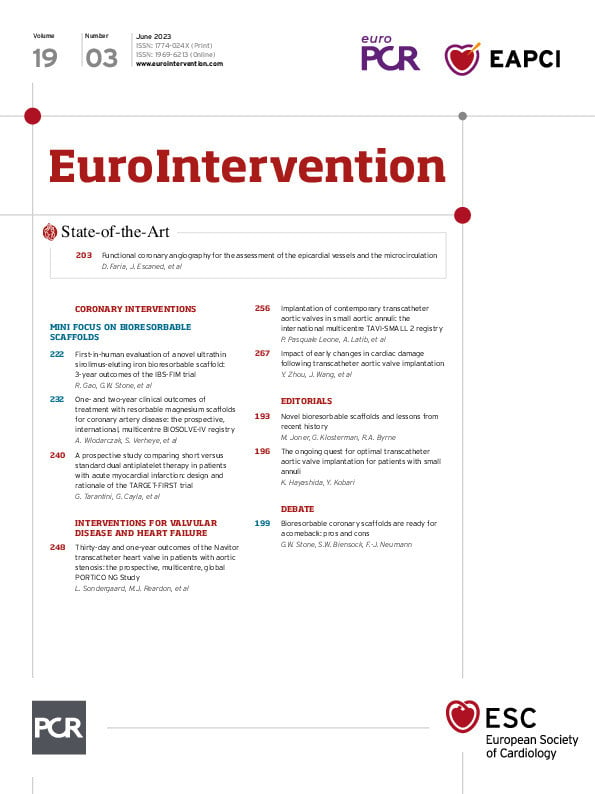Two decades after its introduction, transcatheter aortic valve implantation (TAVI) has been widely accepted as an established treatment for patients with symptomatic severe aortic stenosis across all surgical risks, and the number of patients undergoing TAVI is increasing worldwide12. However, certain challenges, such as prosthesis-patient mismatch (PPM)3 and paravalvular leakage (PVL)4 after TAVI, need to be addressed.
The concept of PPM3, that is, the effective orifice area of the implanted valve being smaller than the anatomical orifice area of the patient, was originally introduced in the context of surgical aortic valve replacement (SAVR). The incidence of PPM in patients who undergo TAVI is likely to be lower than in patients who undergo SAVR. Since a more favourable haemodynamic status can possibly lead to better clinical outcomes and decrease the incidence of structural valve deterioration, it is crucial to minimise severe PPM, especially in patients with small annuli5. Although it is well known that supra-annular valves and/or self-expanding valves offer better haemodynamic outcomes due to the position of the leaflets, the incidence of PPM for current generations of transcatheter heart valves (THV) has not been fully evaluated in patients with small aortic annuli.
In this issue of EuroIntervention, Leone et al6 present the results of a multinational, multicentre registry-based study (TAVI-SMALL 2 registry) comparing clinical outcomes and echo-based parameters (PPM, PVL, etc.) between self-expanding (SEV) and balloon-expandable valves (BEV) and supra-annular (SAV) and intra-annular valves (IAV) in 1,378 patients with small aortic annuli treated with relatively new-generation valves (Evolut R/PRO [Medtronic], ACURATE neo [Boston Scientific], Portico [Abbott], and SAPIEN 3 [Edwards Lifesciences]). The authors demonstrated that 1) IAV and BEV were associated with higher mean aortic valve gradients and incidence of severe PPM compared to those with SAV and SEV, 2) the incidence of more-than-mild PVL was higher after use of SEV than after BEV, and 3) after adjusting for baseline characteristics using inverse probability treatment weighting methods, similar results were confirmed for both PPM and PVL. This study is unique in that the authors clarified, for the first time, the differences in clinical outcomes and echocardiographic parameters among the 4 different types of commercially available THV in patients with small aortic annuli.
However, there remain some points to be discussed. First, there is a substantial difference in haemodynamic assessment between the echocardiographic and invasive catheter-based measurements, known as “discordance”. Unfortunately, invasive catheter-based assessments were not included in this study; therefore, cautious interpretation of this study is required, and further studies are needed to clarify this point. Second, although the difference in echocardiographic measurements between the SEV and BEV groups was statistically significant, there was no significant difference in mortality, presumably because of the higher incidence of PVL in the SEV group. We reported similar results in the OCEAN-TAVI registry7. Future studies using new devices with lower rates of PVL (Evolut FX [Medtronic] and SAPIEN 3 Ultra RESILIA [Edwards Lifesciences]) are required to elucidate the impact of PPM after TAVI. The impact of PPM on the incidence of structural valve deterioration is also of great interest. Further studies focusing on this topic are required to clarify this issue.
Currently, we are actively discussing “lifetime management”, as the indication for this procedure is expanding to younger patients. Patients with SAV may have a more durable valve due to better haemodynamics; however, when the valve deteriorates, TAV-in-TAV may not be feasible in the majority of patients with small aortic valve complexes because of the risk of sinus sequestration and more challenging future coronary access. Additionally, surgical explant of a THV is sometimes challenging for patients with SAV/SEV8. Therefore, treatment decisions for patients with small aortic annuli should be based on individual factors, such as life expectancy, aortic valve complex, body size, preprocedural aortic regurgitation, pacemaker risk, future coronary access, and feasibility for repeat TAVI procedures, rather than solely on early haemodynamic improvements.
The authors should be applauded for this great achievement of using real-world data to clarify the important remaining questions in this field.
Conflict of interest statement
K. Hayashida is a clinical proctor for Edwards Lifesciences, Medtronic, and Abbott. Y. Kobari has no conflicts of interest to declare.

